Abstract
The increasing role of emerging technologies, such as big data, the Internet of Things, artificial intelligence (AI), cognitive technologies, cloud computing, and mobile technologies, is essential to the business process manager profession’s sustainable development. Nevertheless, these technologies could involve new challenges in labor markets. The era of intelligent business process management (BPM) has begun, but how does it look in real labor markets? This paper examines the hypothesis that the transformation of the business process manager profession has been caused by certain determinants that involve the need for an improvement in BPM skills. The main contribution is a model of the dimensions of the impact of digital technologies on business process management supplemented with skills that influence the business process manager profession. The paper fills the gap in research on perspectives of the impact of digital technologies on business process management, considering both a literature analysis and labor market research. The purpose of the literature review was to identify the core dimensions that drive the use of emerging technologies in business process management. The labor market study was conducted in order to analyze the current demand for core skills of business process managers in the Polish labor market with a particular emphasis on the intelligent BPM concept. Additionally, to study the determinants that slow down the iBPM concept’s development, the digital intensity level of the enterprises and public administration units in Poland was studied. Finally, a fuzzy cognitive map presenting the core determinants of the business process manager profession’s transformation is described.
1. Introduction
Even before the COVID-19 pandemic, it has been argued that careers have been changing; they are becoming more complex and unpredictable. Most of the contemporary scientific papers studying careers emphasize their changing nature [1]. On the other hand, the COVID-19 pandemic is increasing the importance of the regulation of and stabilization in today’s labor markets.
Currently, the global economy is in freefall, millions of people have lost their jobs, livelihoods have been undermined, primary healthcare in most countries is in a critical condition, and mental health and domestic abuse are at crisis levels [2]. Sustainable careers have a significant influence on labor markets.
The grand challenges that humanity faces—poverty, inequality, hunger, conflict, climate change, deforestation, and pandemics, among others—hinder sustainable development [3]. Georg Scherer and Christian Voegtlin state that fundamental changes in behavior, as well as in the modes and processes of production and business, are occurring more generally.
Moreover, Joel Baum and Heather Haveman argued that “the digital revolution has expanded the capacity of businesses to disperse their activities geographically and to design and deliver goods and services in novel ways”. Consequently, these changes have influenced organizational strategies, structures, and processes [4].
This inspired the author to set the question of whether these changes are actually visible in the labor market. In other words, the purpose of this research was to discover the advances in business process management that were affected by emerging technologies.
The impact of digital technologies on organizations is one of the trending topics in careers research [5]. The impact of emerging technologies on organizations and professional work has been significant and often brings about new challenges. It has been proven that digitized processes can change incrementally over time [6].
As a result, managers are charged with new tasks and responsibilities and exert intensified managerial control. The monitoring and analysis of new tasks and the competencies associated with them are of great importance to current sustainable and smart organizations.
According to Jan Mendling, Brian Pentland, and Jan Recker, much research on digital innovation and process management has been conducted by different communities [7]. The authors argue that a synthesis is required to connect these separate streams of research.
In [8], the authors argue that the recent emergence of technologies such as machine learning, robotic process automation, and the blockchain will reduce the influence of human factors on business process management.
The research that has expanded our knowledge of professional role identity by showing the value of an in-depth analysis of the content indicates that the missing link between the interpretation of technology and institutional logics is a guiding principle for professions [9].
Finally, a report on the BPM Institute from Forrester Research highlights the importance of improving BPM skills [10]. The company argued that the lack of sufficient business process skills continues to hamper the progress and dynamics of enterprise-wide business process management initiatives, leading to continued over-reliance on professional BPM software vendor services and system integrator resources [10]. They also underlined the current presence of a skills gap and argued that this fact has delayed improvements in business processes across enterprises.
To address the abovementioned gaps, this study aimed to answer the research question of how the business process manager profession in Poland is being affected by the “iBPM” concept and related technologies.
Taking into consideration the suggestions made in the work of Brock, Leblebici, and Muzio [11], the research was built upon an analysis of scientific and organizational responses.
The research tested the hypothesis that the transformation of the business process manager profession was caused by certain determinants that involve the need for an improvement in BPM skills. The identification of these determinants is the main purpose of this study.
A combination of two methods—a literature review and labor market research—was used to analyze the business process manager profession’s transformation. For this purpose, the research procedure presented in Figure 1 was used. The data were collected in two steps. The first step focused on the literature review, with the aim of furthering our understanding of how the current demand for business process professionals is affected by emerging technologies and concepts. In the second step, the nature of the demand for business process managers in Poland was explored in more detail.

Figure 1.
The research framework.
The article is structured as follows. First, previous research on the business process management concept and its development from a traditional to an intelligent perspective were described. Next, the concept of intelligent BPM and its main dimensions were presented and analyzed. This was followed by a description of the methodology, including a presentation of the features of professional and managerial healthcare logic. Finally, implications, limitations, and directions for future research are discussed.
2. Literature Review
2.1. Carriers’ Development
The literature review concentrated on the identification of the tendencies and dimensions of the impact of emerging technologies on the business process manager profession.
At the beginning, the perspective of sustainable carries skills model creation was studied. In “Handbook of Career Theory”, authors define the career from different perspectives, referring to Becker, Doeringer, and Piore [12]. From their suggestion, from an economic perspective, a career should be treated as a response to market forces. Therefore, the research presented in this paper was based on the abovementioned perspective.
Drawing on the degrowth literature in sustainable careers, several papers are concentrated on sustainable careers analysis. The paper by De Vos et al. (2020) “aims to move the research field on sustainable careers forward by building conceptual clarity about what a sustainable career means and delineating what distinguishes sustainable from non-sustainable careers, thereby providing key indicators of a sustainable career” [13]. In the work of Ellen Kossek and Ariane Ollier-Malaterre (2020), the authors focus their work on the implementation of sustainable reduced load work and shed light on key issues [14].
2.2. Sustainable BPM
The concept of sustainability can be found not only in sustainable carriers, but also in ecological economics, sociology, and political ecology. In their work [15], the authors identify key principles relevant to processes of organizing for a more just and environmentally sustainable future [15]. Consequently, one of the most important directions of change are green initiatives towards sustainability development, such as green bpm, green finance, green cities, green information systems [16,17,18,19,20,21], etc. According to von Brocke, Seidel, and Recker (2012), green BPM is the pathway to sustainable enterprise [20]. Green Business Process Management focuses on the ecological impact of business processes and related technological development [17,18]. Currently, it is an emerging field, and different approaches exist to realize it. It is also associated with sustainable BPM.
In the paper by Couckuyt and Van Looy, the authors describe the literature analysis that revealed the connection between Green BPM and the sustainability development concept [22]. Their results describe Green BPM as an approach for environmentally sustainable organizations.
Other research treated sustainability in BPM as a more extended concept [23,24,25,26,27]. Therefore, based on Seidels et al.’s work (2010), the authors propose to extend the “devil’s quadrangle” with the factor “sustainability” [20].
Similarly, Schormann et al. state that previous research on sustainable BPM and green BPM seeks to consider ecological concerns in addition to economic obligations [28]. Social sustainability is mostly neglected in scientific research. "This deficiency hinders businesses from being guided on how to systematically consider social aspects such as fair and healthy working conditions. Accordingly, this study makes use of a process pattern-based approach to provide proven, general solutions for common problems referring to “social sustainability” [28]. Some authors viewed BPM as a tool for implementing the concept of sustainable development [29].
Another emerging direction is the direction of the concept which has been evaluated from intelligent organization to smart organization. The term “smart organization” is used for organizations that are knowledge-driven, technology-driven, internetworked, dynamically adaptive, learning, and agile [30]. A smart organization is also an organization that is safe, principle-driven, and value-focused. The term “smart organization” is closely related to the term “smart city”.
The relationship between professional associations, multinational corporations, international organizations (such as the EU, WTO, and OECD), and nation-states is in rapid transition [11]. Accordingly, the research results of the abovementioned organizations could be taken into consideration during the professions’ transformation analysis.
The development of networking and social media and the pandemic have had an impact on the way of working. The rise in remote working has resulted in the development of remote work skill models. The Workplaceless Remote Work Competency Model is a framework of essential competencies needed to succeed in remote work [31]. This model provides a holistic view of the competencies (attitudes, behaviors, knowledge, and skills) needed by distributed workers, team members, leaders, and executives. Change management, performance management, conflict management, team culture, communication management, remote leadership tools, stakeholder management, resource management, and innovation are all skills that a new remote leader should have [31].
A report by the McKinsey Global Institute highlights “how jobs based on human skills will be affected by AI and automation” [32]. The Accenture company, in its “Future Skills Pilot”, also states that artificial intelligence will force organizations to create more job pathways [33]. A million jobs may be changed by using machines by 2025. Due to these changes [33], one million new roles may emerge by 2025. It also highlighted the importance of eliminating bias in human work. Accenture also emphasizes the role of cross-industry collaboration and fostering culture change.
In the paper by Tarafdar, Beath, and Ross (2017), the authors highlight the importance of using cognitive technologies and provide an overview of enterprise cognitive computing applications [34]. They specifically identify opportunities for developing these applications and describe implementation challenges [34]. Their findings are based on a study of 51 application initiatives across a broad range of industries in different continents.
The OECD skills report focuses on other issues. It has been mentioned that high cognitive skills, social and emotional skills, and technological skills will be crucial for the next decade [35]. According to the OECD report, the greatest demand will be for computers and electronics knowledge areas, decision-making and judgment skills, systems evaluation, and system analysis. It presents the shortages (e.g., unsatisfied demand in the labor market for the analyzed dimension) [34].
Moreover, according to the OECD ranking, it is hard to find employees in Poland with the following competences related to managerial positions [35]:
- Manufacturing and production: Understanding of the principles and facts relating to the manufacture, processing, storage, and distribution of manufactured and agricultural goods.
- System Skills: Systems evaluation, systems analysis, judgment and decision-making developed capacities used to understand, monitor, and improve socio-technical systems.
- Complex problem solving: The ability to solve novel, ill-defined problems in complex, real-world situations.
- Knowledge of the practical application of engineering science and technology. This includes applying principles, techniques, procedures, and equipment to the design and production of various goods and services (mostly in computers and electronics).
- Knowledge of principles and facts related to business administration and accounting, human and material resource management in organizations, sales and marketing, economics, and office information and organizing systems—was in excess.
The analysis of common tendencies allowed to highlight the main drivers for BPM transformation: sustainable carriers and development, green initiatives, increasing amounts of remote work and networking, demand for intelligent technologies, cognitive and emotional skills, and direction toward decision making rather than routine operations.
2.3. Changes in Business Process Management Concept
The BPM discipline continues to improve its value due to digital transformation [36]. However, most organizations have started or at least planned digital transformation initiatives [36]. The process of digital transformation is significantly influenced by internal embeddedness [37].
Kirchmer (2021) and Javidroozi et al. (2020) describe the challenges and factors associated with business process changes [38,39]. The study by Javidroozi et al. (2020) proposes a conceptual framework for addressing BPC challenges and their success factors, as well as supporting solution providers to develop solutions for effective and efficient BPC [39]. The authors also argue that “enterprise systems integration is necessary for today’s business environment to access real-time data and quickly respond to fluctuating market demand” [39]. According to Kirchmer (2021) and Binci, Belisari, and Appolloni, RPA, low code, change management, AI, stakeholder management, and digital governance technologies are currently in demand [38,40].
Furthermore, last year, agile methodology became popular. Experts demonstrated that in order to improve business processes, the values and principles of agile methods such as Scrum and various agile practices such as Kanban should be applied [41].
Moreover, emerging technologies implemented in BPM projects affect the results of BPM improvement. These technologies are smart production systems, big data analytics, cyber-physical systems, and the Internet of Things (IoT) [42]. In the paper by Battisti et al. (2020), the authors describe the role of integration between big data, risk management, and BPM and study the impact of this relationship on risk management efficiency and business process optimization [43].
Software solutions simplify the implementation of BPM and shift the responsibilities from people to technology [44]. Robotic process automation is helpful in improving enterprise efficiency and reducing costs [45]. Experts also argue that more research on the use of AI in organizations should be conducted. They also highlight that “a substantial change is required in how AI research is currently conducted in order to develop meaningful theory and to provide practitioners with sound advice” [46].
According to Leotta et al. [47] IoT can provide many opportunities for improving BPM initiatives. In particular, the IoT supports reducing the need to manually signify the completion of manual tasks by using sensor data. It also helps to acquire more accurate data, to reduce errors, and increase efficiency gains [48]. On the other hand, “it still involves challenges that require enhancements and extensions of the current state-of-the-art in BPM” [47].
Another emerging trend is the blockchain technology—“a shared ledger for parties collaborating on a process” [49]. The blockchain technology also significantly affects the human factor in BPM [50].
A growing trend toward partnership and network development of a “network society” was observed. Interdependence and horizontal relations have grown in importance due to the influence of information technologies [51]. Moreover, networking skills become a meaningful factor for career success. Social technologies have an impact on work planning and collaboration in BPM [51,52,53,54,55]. The research also noticed the effectiveness of cognitive technologies’ application to social networks and building cognitive social structures [56]. They can also help to improve the managers’ effectiveness in their leadership roles [57,58]. Scientists argue that the next step in networking concept development is processual communication networks [59].
It should be noted that there are several differences between men’s and women’s networks for career success. Meredith Woehler et al. in 2021 [60] proposed “guidance to organizations aiming to address inequality resulting from gender differences in network creation and utilization”.
Last year, a significant number of works on low-code and even zero-code technologies appeared [61], owing to more advanced technology analysis.
Analyzing the determinants from the management perspective, it was noticed that many authors proved that BPM is closely related to project management. Moreover, currently, boundaryless career theory has been the dominant career perspective in project management research [62].
BPM is also related to knowledge management [63]. Knowledge-intensive business processes are crucial for knowledge creation and have become a popular topic of scientific research [64]. Thus, in the paper [63], the authors propose a theoretical framework including a holistic model of BPM reversed knowledge pyramid [63]. It has also been confirmed that “knowledge-intensive processes require another approach to their ongoing improvement” [65]. Knowledge-intensive processes can be supported by process-based knowledge management systems [66]. The research on knowledge-intensive processes involves the BPM evolution toward an intelligent BPM concept.
BPM is also related to change management. In the work of Binci, Belisari, and Appolloni (2020), the authors outlined the perspective of a combination of BPM and change management [40]. The changes in BPM systems technology were caused by the changes in the nature of business processes, from routine processes to cognitive-intensive processes [67]. The core processes are still the same, but the changes in the business environment and emerging technologies have changed them significantly, in particular their functionality and complexity (Figure 2).
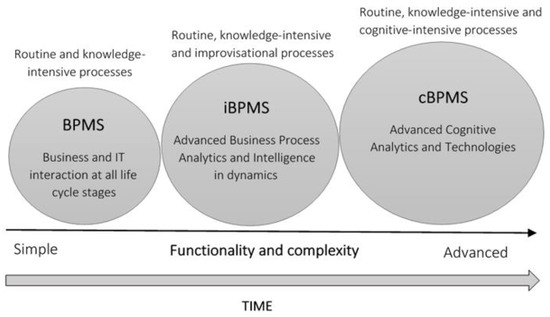
Figure 2.
The Model of BPM software transformation. Source: own preparation based on [67,69,70].
These changes lead to replacing workers doing routine and methodical tasks. Intelligent BPM systems support workers with high problem-solving skills, leadership, emotional intelligence, empathy, and creativity skills. Intelligent BPM systems offer solutions for human collaboration, such as integration with social media, mobile-enabled process tasks, deep analytics, and real-time decision management [68].
The BPM systems evolve from the simple form to advanced, complex systems (Figure 2). However, only a few papers on cognitive BPM systems have been published [67,71,72,73,74]. Mostly, these are conceptual works published by IBM managers. Thus, in the work of Hull and Nezhad, the components of the cognitive BPM (cBPM) concept are described [71]. Nezhad and Akkiraju (2015) also mentioned the pursuit of cognitive process management [72].
One of the core advantages of the application of intelligent technologies to BPM is that they enable change management inside their organization by enabling processes to improve themselves without human intervention [73].
Moreover, research suggests that the adoption of cognitive technologies in BPM will improve performance [74], especially machine learning (ML) algorithms [49]. Evermann et al. (2017) argue that these cognitive technologies can be used to generate views and processes customized for an end user [49].
Moreover, predicting business process behavior has become possible due to natural language processing [75]. For example, in the paper [75], the authors describe an application of deep learning with recurrent neural networks to the problem of predicting the next event in a business process [48].
Currently, intelligent BPM software leads the world market. Nevertheless, the era of cognitive business process management has been initiated. Cognitive BPM means cognitive decision support, cognitive process learning, cognitive interaction with processes and cognitive process enablement, and cognitive issues in BPM visualizations.
Several research studies concentrated on complex analysis of the determinants influencing the BPM concept transformation were conducted. Thus, Szelgowski and Lupeikiene (2020) define the current core capabilities of BPM as: real-time business analytics, content interaction management, human interaction management, business rule management, social-media, case management in dynamic processes, business pressure, changes in social culture, real-time decision making, and new technologies such as: low-code applications, mobility, cloud computing, or predictive analytics, process mining, social collaboration, robotic process automation, Blockchain, IoT, or ML/AI [76,77].
All the above-mentioned determinants have an impact on skills models and BPM certification program structure. The certification programs ought to represent the current demand in labor markets.
2.4. Certification Programs Analysis
The competence models are the basis for certification programs. Currently, there are several certification services, such as: ABPMP Certified Business Process Professional (CBPP), Business Process Management Certification from BPM Institute, Business Process Management Certification from AIIM, Business Process Management Certification from Bizagi, and Object Management Group (OMG) BPM Certification. For example, The ABPMP BPM Competency Model consider the knowledge, skills, competencies, and experience levels for a practitioner in Business Process Management. It provides a developmental path that aligns knowledge, skills, and competencies with the ABPMP BPM Certification Levels.
Most certification programs define the “business process leader” or “business process professional” status as the most coveted.
Some certification programs have already been supplemented with new certificates in emerging technologies skills as a result of BPM system transformation. Thus, the Dbiz institute offers certification with analytics and big data, statistics, OpEX tools, change management, agile methodology, data management, data visualization, date governance, DMN, RPA, Lean, and Six Sigma skills.
2.5. BPM Concept Development in Poland
It has been noticed for years that BPM concept implementation in Polish companies is problematic enough. In the paper [78], the authors present the findings of a process approach in Polish companies in 2007. They also describe consequential difficulties with the process management. Enterprises encounter consequential difficulties with process identification and process management [78]. As basic difficulties in process management were defined functional organization structure, and the problems in information flow between organizational divisions.
The authors also highlighted the fact that, in the majority of firms, employees actively participate in process realization, and they have the possibility of notifying improvements [78]. Polish firms are aware of the need to use tools for the measurement of process effectiveness.
Similarly, another problem identified was determining the level of process maturity in the surveyed municipal office [79]. The research results show that 178 (78.8%) of municipal offices did not undertake any projects related to the implementation of process management or took only selective action, not using comprehensive projects at any level of process maturity [79]. The undertakings most frequently implemented by municipalities are the identification of main processes, their optimization, and their description in the form of process maps or graphical diagrams. This procedure was performed by 26.1% of all surveyed municipia.
The author of work [80] defines, among others, the following project barriers in strategic management processes in Polish enterprises: information noises or lack of information and lack of qualified employees.
In paper [81], the authors present the results of the empirical procedure carried out in 2017 on a random sample of 350 organizations in Poland, answering questions regarding the desired role of an employee as a leader.
The empirical research was conducted in order to analyze the current state of the Polish labor market and the demand for BPM managers.
3. Materials and Methods
The second part of research methodology was empirical analysis of job posts using job searching websites according to the methodological scheme presented in Figure 3. While it was found that the development of iBPM systems is currently at an initial stage, the selected statistics from the Polish Information Society Report were analyzed to define the determinants which could spawned BPM implementation development [82,83].
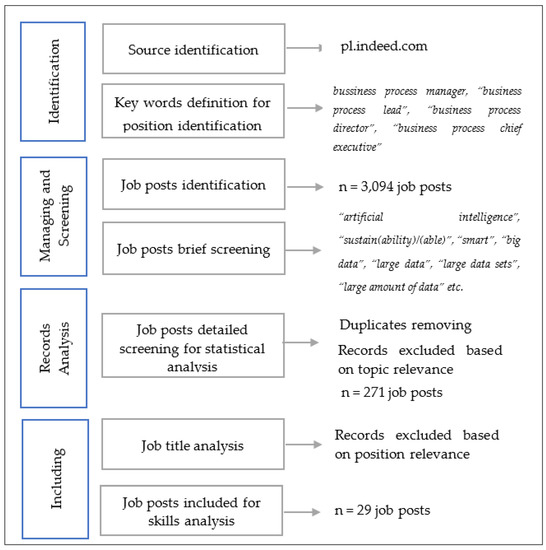
Figure 3.
Methodological scheme of the job posts analysis.
3.1. Data Collection
The research was conducted in April and June of 2021. The first results were obtained at the beginning of April, and after that, they were checked twice more until the beginning of June.
The first stage included an examination of job-searching websites. Among others, the pracuj.pl and indeed.pl websites were selected [84,85,86,87]. However, it turned out that the indeed website was more appropriate due to the great number of job offers provided. Consequently, the “Indeed” job search website was chosen for further research.
About three thousand job postings were processed. Job posts were filtered using the “Indeed” website searching engine by entering the following key words into the webpage searching field: “business process” manager, or “business process” leader, simultaneously with “artificial intelligence”, “sustain (ability)/(able)”, “smart”, “big data”, “large data”, “large data sets”, “large amount of data”, “ERP”, “English” etc. The website’s search mechanism has found many relevant positions, such as, for example, business process manager, business process improvement manager, lead business process expert, process excellence senior manager, and others.
Finally, 271 job posts were analyzed. After the title relevance analysis and duplicates being removed, the offers of 29 enterprises were selected for the skill analysis.
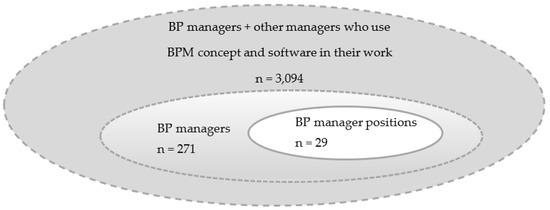
Figure 4.
The record set’s representativeness according to data acquired using website searching engine.
3.2. Data Analysis
Each job post was analyzed on the basis of information about requirements and the company.
As the research study has shown, the following groups of skills are essential in the Polish labor market for BPM managers: management skills, emerging technology skills, language skills, and selected social and behavioral skills.
The following management skills were noticed: human resource management, relationship management, project management, quality management, flow management, supply chain management, data management, contract management, change management, stakeholder management, value management, risk management, product management, knowledge management, talent management, and capacity management.
The most required were the skills related to project management (58%) and change management (32%) (Figure 5).
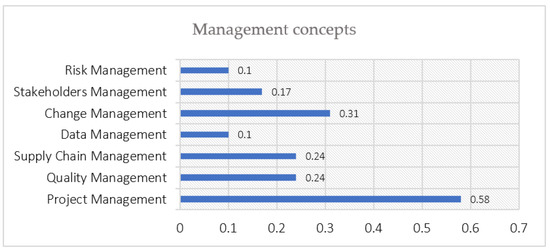
Figure 5.
Management concepts required for BPM managers in Poland.
It was noticed the significant share of information technology skills (Figure 6). The most required were the skills of ERP systems—48%, predominantly SAP software. Moreover, technologies such as big data, agile tools, artificial intelligence, robotics, programming, business intelligence (BI) and analytic tools (Tableau, Power BI), cloud computing, BPM and process flow software (ARIS, Oracle BPM, Flowable, ServiceNow, Ms Visio), and statistical software were mentioned in job posts. Figure 6 presents the most significant ones.
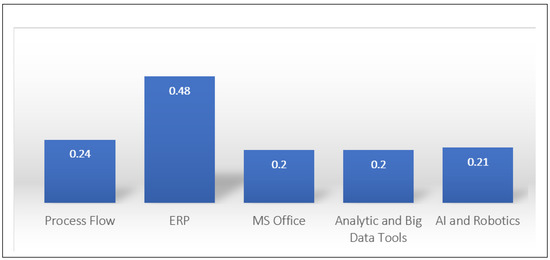
Figure 6.
IT tools required for BPM managers in Poland.
The knowledge of methodologies associated with BPM concept was also required, namely Lean, Six Sigma, Scrum, Drive, Kaizen, and Smart Opex Framework.
It was also noticed around 48% included requirements in certificates associated with the following concepts: Lean Practitioner, Green Belt, AGILE certificates, Scrum, PMP, and Prince. Interestingly, almost every third company was looking for managers with competence in the finance and accounting domain, namely 28%. Most of the job posts were published by multinational enterprises. Consequently, the knowledge of foreign languages was required for 79% of the following: English, German, Danish, and Spanish, with a huge advantage for English (Figure 7). Moreover, multicultural competencies (41%), communication abilities, and willingness to travel were required.
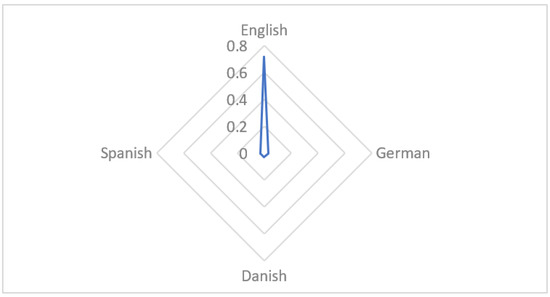
Figure 7.
The Language requirements for BPM managers in Poland.
Some companies have highlighted the importance of the ability to stimulate knowledge sharing.
Furthermore, problem solving skills (45%), analytic skills (80%), reporting skills (21%), and leadership skills (65%) were mentioned.
Next, the spatial distribution of job offers was analyzed (Figure 8). A total of 11 voivodships offered jobs for business process managers. The most offers were posted by Warsaw companies—35.8%, Lower Silesia—17%, and Malopolskie Voivodship—18.7%. The rest of them offered less, about 5%, of the job positions; 2.1% of job posts were offered in remote mode.
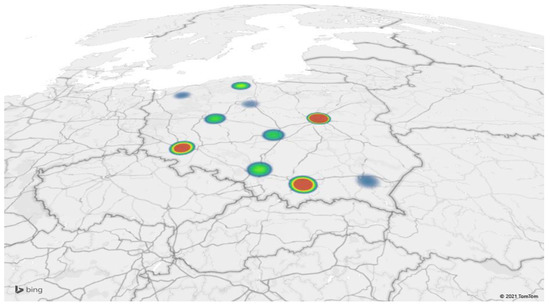
Figure 8.
The heatmap of spatial distribution of job offers for business process manager’s positions by voivodships.
4. Results
The research allowed to create a holistic picture of BPM manager skills in Poland based on the main characteristics (requirements). The requirements with the greatest percentage result were included (Figure 9).
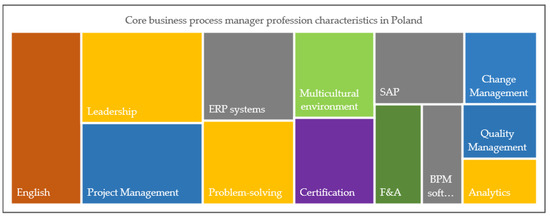
Figure 9.
The tree of core business process manager profession current characteristics (skills) in Poland according to labor market perspective.
The literature analysis reveals four core directions of BPM systems development: continuous sustainable improvement, digitalization, income increasing, control intensification. These four directions are tended to the creation of determinants which currently influenced the BPM.
The determinants extracted in Poland were in line with core global determinants identified in the result of literature review. However, comparing the determinants of impact of emerging technologies on BPM conception and real situation on the labor market, it could be concluded that not all of these determinants are present in the Polish labor market.
The analysis reveals that BPM manager profession in Poland is cross-culture centric, project management based, and technology centric with the focus on ERP systems.
The determinants wheel supplemented with core skills was presented in Figure 10. It was divided on two equal parts: the left with traditional concepts and the right with more recent concepts. Most of the transformations involved by implementation of emerging technologies have occurred and presented in the right part of the model. The model presents the dimensions of impact of emerging technologies on BPM concept transformation.
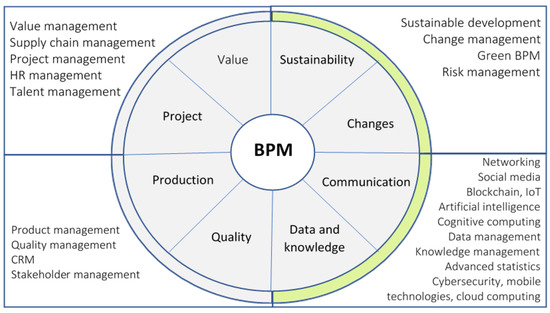
Figure 10.
The model of skills of business process manager profession in Poland.
On the basis of empirical analysis, the following findings were defined:
- Currently, companies in Poland are not looking for certified BPM managers. They just require the additional certificates in related concepts such as Lean, Six Sigma, Prince, etc.
- Due to the global COVID-19 situation, many BPM companies are delivering their work remotely. However, their work model is based on traveling and serving as advisors, and working closely with the clients. Nevertheless, the willingness and ability to work at clients’ locations can become very challenging.
- Further transformation could lead to extending the practice of remote work.
- The multicultural nature of the BPM advisory service involves the need for advanced English language knowledge.
- Many companies require financial and accounting knowledge.
- Certification programs for business process leaders should include skills in emerging technologies.
- I have not found any job posts for public or government organizations in Poland.
- The determinants of transformation extracted in Poland are in line with the core global determinants identified in the result of the literature review.
- The iBPM concept and tools are currently at the initial development stage in Poland.
Due to this fact, the deeper analysis of the determinants may have caused the iBPM’s slow development.
As the BPM manager profession requires the advanced information technologies using such as big data, cloud computing artificial intelligence, robotics, cognitive technologies, Internet of Things, and the statistics on ICT level in enterprises and public administration units were analyzed.
First, the digital intensity index was analyzed, which helps to estimate the whole situation of digitalization based on Information Society 2021 Report [82,83]. The Eurostat’s methodology for estimating the indicator consists of assigning each enterprise to one of four levels of digital intensity [82]. For each condition met, a point is awarded, the sum of which determines the level of digital intensity. In 2019, only 0.8 percent of the Polish enterprises were the high level of the index. On the other hand, 60.4 percent noted a very low level, and 29 percent—at low level. This result gives Poland the 24th position out of 26 counties. In 2018, the 56.3 percent of companies noted very low digital intensity level, 31.1 percent low level, and just 1.5 percent very high level [82].
In 2017–2019, the business process innovation level was 12.9% in the ICT sector (data for the ICT sector in total and ICT services exclude enterprises classified into NACE group 95.1) [82]. Interestingly, in 2016-2018 this level was 18.8% [83].
“Innovation of business processes” was understood as the “introduction of new or improvement of business processes in the enterprise, within one or more business functions, which significantly changed the business processes used so far [82]. These include new methods of manufacturing (producing) products or providing services (including the development of products or services); logistics, delivery, or distribution methods; methods of information or communication processing; accounting methods or other administrative activities; principles of operation within the company or in relation to the environment; methods of division of tasks, decision-making powers, or human resource management; marketing methods in the field of packaging, product pricing, promotion techniques, product placement, or after-sales services” [82].
While the core elements of the iBPM system are mobile technologies, social media, analytics, and real-time decision making, the reports of the Information Society in Poland in Polish enterprises were further studied from these perspectives (Table 1).

Table 1.
The main specifications of the Polish enterprises in 2019–2020 year by enterprise size. Source: own preparation on the basis of [82,83].
In 2016–2020, the percentage of enterprises with broadband Internet access across the country exceeded 98% [82], gradually increasing the number of enterprises with access to the Internet. In 2018, the percentage of enterprises in Poland with Internet access was 1 percentage point lower than the average for the European Union at 97% [83].
The dynamic development of BPM technologies makes it necessary to improve the ICT competences of employees.
An investment in training is inevitable. However, the low rate of investments in training in ICT skills improvement was noticed in 2019 [82]. According to the report, Poland occupied the lowest 24 position among the other 27 European countries that provide training for personnel to develop ICT skills in 2019 [82]. In total, 15.9% of enterprises offer trainings to other personnel groups. However, training investments in both types of employee groups increased over the previous year, with a total of 6.4 percent for ICT employees and 11.5 percent for other employees, up from 7.8 and 15.9 percent in 2019, respectively [82,83].
Moreover, it was found that a certain number of enterprises have hard-to-fill vacancies for ICT specialists.
In 2019, 11% of Polish businesses purchased cloud computing services. It was a lower result by 13 percentage points than the average in the European Union (24%) [82]. Investments in cloud computing paid services were increased compared to the previous year’s total, from 17.5% to 24.4% [82,83].
In 2020, the most frequently purchased cloud computing services were those related to the provision of e-mail and office software. They were the most popular in the large enterprise’s group [82]. In 2019, the percentage of enterprises in Poland purchasing cloud computing services was lower by 13 percentage points than in the European Union average (24%). This result was one of the worst in the EU [82,83].
In 2019, in Poland, the percentage of enterprises conducting big data analysis was 8.5%. The greatest interest in services of this type was shown by large enterprises, 28.4% of which used big data analysis [82].
The level of usage of robots’ services was close to the EU average level of 7%. In 2019, in Poland, the percentage of enterprises using robots was mostly similar in comparison to the 2020 year [82,83]. In 2019, the percentage of mobile devices in enterprises in Poland (76%) was higher than the EU average (69%) [82]. Investments in cloud computing paid services were increased compared to the previous year’s total, from 76.2% to 78.3% [82,83].
In 2019, over a quarter of enterprises used ERP software, and slightly more entities used CRM tools in their activities. All the types of information exchange tools were most often used by large companies (87.3%) [83].
Every third enterprise in Poland in 2019 used at least one social media platform (35.4%) [82]. Investments in social media increased by 28.9% in total compared to the previous year [82]. The most popular tool was social networking.
To continue, while the BPM concept has been widely implemented in public administration, these units were also taken into consideration.
Due to the differences in demand and organizational specificity, not all the criteria that were taken into account in the report were identical to enterprises level report (Table 2).

Table 2.
The main specifications of public administrative units in 2019 by types. Source: own preparation on the basis of [82,83].
In 2019, public administration units provided their employees with ICT training more often than local government administration (87.6% and 52.7%, respectively) [82]. It is worth noting that such training was organized by over 93.8% of marshal offices and 87.6% of state administration. Training investments increased from 49.8 percent to 54.1 percent in total from 2018.
In 2019, the percentage of public administration units using broadband technology for Internet access via a permanent connection was 99.8% [82]. Total investments in mobile devices increased from 15.0% to 15.5% [82,83] compared to the previous year.
BI tools were used by 36.3% of state administration units and only 2.6% of local government units [82]. The highest number of public administration units that were used the BI tools was noticed in marshal offices (50.0%). In municipal offices, this percentage was only 1.8%, and in district offices, it was 5.4%. Investments in BI were increased compared to the previous years.
Summing up, there was a gradual increase in investments in all analyzed technologies, both in administration and in enterprises. Large enterprises are better prepared for business process manager profession transformation than average and small ones. In the public sphere, the marshal office’s and state administration’s level of digitalization give the expectation of obtaining better results in the case of iBPM concept implementation.
To structure the determinants gathered, based on the literature, labor market research and Information Society reports analysis, the fuzzy cognitive map with core determinants impacted the transformation of business process manager profession was created (Figure 11).
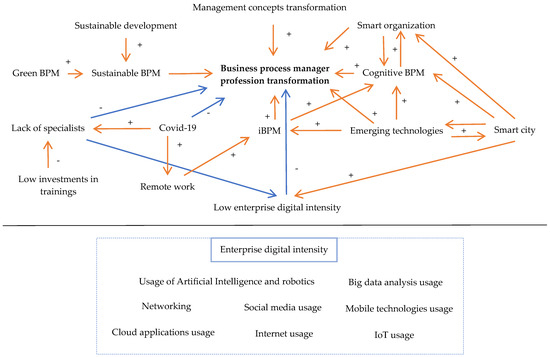
Figure 11.
The fuzzy cognitive map of the business process manager profession transformation. The blue arrows show the decreasing impact, the orange—increasing impact.
This study has several limitations that could be corrected in future research. The main limitation is that the labor market research was conducted under the COVID-19 conditions. The pandemic may have had an impact on the number of job offers. The research could be repeated as the situation returns to normal. Moreover, due to the differences in demand and organizational specificity between enterprises and public organizations, not all the criteria analyzed in the Information Society Report were the same. This lowered the quality of the comparison. Next, the research is based on literature analysis, labor market, and Information Society reports. The opinion of the enterprise owners and executives could also be taken into consideration to ensure a holistic picture of the studied topic.
5. Discussion and Conclusions
In this paper, the determinants of the transformation of the BMP concept with a focus on emerging technologies were examined.
The hypothesis that the transformation of the BPM systems is caused by certain determinants that involve the need for BPM skills improvement was proved. The determinants were identified, analyzed, and structured by means of fuzzy cognitive map modelling.
The study has several important contributions. First, the research contributes to the literature on business process management. The analysis demonstrates a critically important topic for BPM theory: the determinants of BPM profession development.
Second, it contributes to the literature on labor market research by describing the research method based on literature research and labor market study. Traditionally, the labor market study is conducted by means of interviews. This method is hard to implement in current pandemic conditions.
The range of practical application of the results of research could be quite long. The current study’s findings can contribute to knowledge and practice by being used in the process of developing an BPM manager competency model in commercial and non-commercial enterprises, as well as in certification and education programs and various training courses. The previous deficiency in research hinders enterprises in being guided on how to systematically and manage the BPM manager’s skills.
Empirically, the article builds on fieldwork observations and current labor market job posting analysis. Using only the literature review, it was hard to measure the extent of the emerging technologies’ impact. Nevertheless, I was able to calculate the descriptive requirements statistics related to each skill in order to create a holistic picture of the current state of the BPM manager profession in Poland.
The core theoretical contribution is the discovery of the core dimensions that drive the emerging technologies in business process management in Poland.
Drawing from the carrier’s general development conditions literature and the tendencies in emerging technologies analysis to the BPM concept, a new consideration of the impact of emerging technologies on BPM profession development was offered.
The paper contributes to the management of professions by suggesting a new framework for analyzing skills as fundamental to business process management based on previous research [86,87].
Future research could be concentrated on attempting to explore the impact of COVID-19 on market demand and transformation. It could also be worth studying how remote work influences the transformation in detail and, in this way, will be the every-day practice for BPM managers in a post-pandemic world.
Funding
This research received no external funding.
Institutional Review Board Statement
Not applicable.
Informed Consent Statement
Not applicable.
Data Availability Statement
Data is available from the sources mentioned in the references.
Conflicts of Interest
The author declares no conflict of interest.
References
- Tracey, L. Professional employees and professional managers: Conflicting logics, hybridity, and restratification. J. Prof. Organ. 2020, 7, 101–115. [Google Scholar] [CrossRef]
- Banerjee, S.; Jermier, J.; Peredo, A.; Perey, R.; Reichel, A. Theoretical perspectives on organizations and organizing in a post-growth era. Organization 2021, 28, 337–357. [Google Scholar] [CrossRef]
- Scherer, A.; Voegtlin, C. Corporate governance for responsible innovation: Approaches to corporate governance and their implications for sustainable development. AMP 2020, 34, 182–208. [Google Scholar] [CrossRef]
- Baum, J.; Haveman, H. Editors’ comments: The future of organizational theory. AMR 2020, 45, 268–272. [Google Scholar] [CrossRef]
- Akkermans, J.; Kubasch, S. Trending topics in careers: A review and future research agenda. Career Dev. Int. 2017, 22, 586–627. [Google Scholar] [CrossRef]
- Pentland, B.; Liu, P.; Kremser, W.; Hærem, T. The dynamics of drift in digitized processes. Mis Q. 2020, 44, 19–47. [Google Scholar] [CrossRef]
- Mendling, J.; Pentland, B.; Recker, J. Building a complementary agenda for business process management and digital innovation. Eur. J. Inf. Syst. 2020, 29, 208–219. [Google Scholar] [CrossRef]
- Mendling, J.; Decker, G.; Hull, R.; Reijers, H.A.; Weber, I. How do machine learning, robotic process automation, and blockchains affect the human factor in business process management? Commun. Assoc. Inf. Syst. 2018, 43, 19. [Google Scholar] [CrossRef]
- Goto, M. Collective professional role identity in the age of artificial intelligence. J. Prof. Organ. 2021, 8, 86–107. [Google Scholar] [CrossRef]
- About Certification. Available online: https://www.bpminstitute.org/certification/about (accessed on 25 May 2021).
- Brock, D.; Leblebici, H.; Muzio, D. Understanding professionals and their workplaces: The mission of the journal of professions and organization. J. Prof. Organ. 2014, 1, 1–15. [Google Scholar] [CrossRef]
- Artur, M.; Hall, D.; Lawrence, B. Generating the New Directions in Carrier Theory: The Case for Transdisciplinary Approach; Arthur, M.B., Hall, D.T., Lawrence, B.S., Eds.; Cambridge University Press: Cambridge, UK, 1989. [Google Scholar]
- De Vos, A.; Beatrice, I.J.M.; van der Heijden, A.J. Sustainable careers: Towards a conceptual model. J. Vocat. Behav. 2020, 117, 103196. [Google Scholar] [CrossRef]
- Kossek, E.; Ollier-Malaterre, A. Desperately seeking sustainable careers: Redesigning professional jobs for the collaborative crafting of reduced-load work. J. Vocat. Behav. 2020, 117, 103315. [Google Scholar] [CrossRef]
- Thornbush, M. Becoming smart. In Sustainable Urbanism in Digital Transitions: From Low Carbon to Smart Sustainable Cities; Sustainable Urbanism in Digital Transitions; Thornbush, M., Golubchikov, O., Eds.; Springer: Berlin/Heidelberg, Germany, 2020; pp. 35–47. [Google Scholar]
- Serhiy, L.; Pimonenko, T.; Bilan, Y.; Štreimikienė, D.; Mentel, G. Assessment of green investments’ impact on sustainable development: Linking gross domestic product per capita, greenhouse gas emissions and renewable energy. Energies 2019, 12, 3891. [Google Scholar] [CrossRef] [Green Version]
- Couckuyt, D.; van Looy, A. An empirical study on Green BPM adoption: Contextual factors and performance. J. Softw. Evol. Process 2020, 33, e2299. [Google Scholar] [CrossRef]
- Couckuyt, D.; van Looy, A. A systematic review of green business process management. Bus. Process Manag. J. 2020, 2, 421–446. [Google Scholar] [CrossRef]
- Maciel, J. The core capabilities of green business process management—A literature review. In Proceedings of the International Conference on Wirtschatsinformatik, St. Gallen, Switzerland, 12–15 February 2017; University of Liechtenstein: Vaduz, Liechtenstein, 2017; pp. 1526–1537. [Google Scholar]
- Vom Brocke, J.; Seidel, S.; Recker, J. Green Business Process Management: Towards the Sustainable Enterprise; Springer: Berlin/Heidelberg, Germany, 2012. [Google Scholar]
- Corrocher, N.; Malerba, F.; Morrison, A. Technological regimes, patent growth, and catching-up in green technologies. Ind. Corp. Chang. 2021, 30, 1084–1107. [Google Scholar] [CrossRef]
- Couckuyt, D.; van Looy, A. Green BPM as a business-oriented discipline: A systematic mapping study and research agenda. Sustainability 2019, 11, 4200. [Google Scholar] [CrossRef] [Green Version]
- Seidel, S.; vom Brocke, J.; Recker, J. Call for action: Investigating the role of business process management in green IS. In Proceedings of the SIGGreen 2010 Workshop: An Introduction. Sprouts: Working Papers on Information Systems; Hasan, H., Dwyer, C., Eds.; Case Western Reserve University, Weatherhead School of Management: Cleveland, OH, USA, 2011; pp. 1–6. [Google Scholar]
- Levina, O. Exploring the Role of Business Process Management in Sustainability Initiatives. In Proceedings of the MCIS 2015 Proceedings, Samos, Greece, 2–5 October 2015; Available online: http://aisel.aisnet.org/mcis2015/35 (accessed on 5 September 2021).
- Lisovsky, A. Sustainable Development and Business Process Management, Strategic decisions and risk management. Strateg. Decis. Risk Manag. 2019, 10, 228–237. [Google Scholar] [CrossRef]
- Opitz, N.; Krüp, H.; Kolbe, L.M. Environmentally sustainable business process management—Developing a green bpm readiness model. In Proceedings of the PACIS 2014: The 18th Pacific Asia Conference on Information Systems, Chengdu, China, 24–28 June 2014. [Google Scholar]
- Sokphea, Y.; Yoon, C.K. Sustainable business process management model for construction companies. In Proceedings of the 28th International Symposium on Automation and Robotics in Construction (ISARC 2011), Seoul, Korea, 29 June–2 July 2011; pp. 430–435. [Google Scholar]
- Stolze, C.; Semmler, G.; Tomas, O. Sustainability in business process management research—A literature review. In Proceedings of the Eighteenth Americas Conference on Information Systems, Seattle, WA, USA, 9–12 August 2012. [Google Scholar]
- Schoormann, T.; Kutzner, K.; Pape, S.; Knackstedt, R. Elevating social sustainability in business processes: A pattern-based approach. In Proceedings of the International Conference on Information Systems (ICIS 2019), Munich, Germany, 15–18 December 2019. [Google Scholar]
- Filos, E.; Banahan, E. Towards the smart organization: An emerging organizational paradigm and the contribution of the European RTD programs. J. Intell. Manuf. 2001, 12, 101–119. [Google Scholar] [CrossRef]
- The Remote Work Competency Model—Creating Success at Every Stage of Remote Work. Available online: https://www.workplaceless.com/blog/remote-work-competency-model (accessed on 11 May 2021).
- The Future of Work after COVID-19. Available online: https://www.mckinsey.com/featured-insights/future-of-work/the-future-of-work-after-covid-19 (accessed on 4 May 2021).
- Future Skills Pilot. Available online: https://www.accenture.com/tw-en/case-studies/consulting/future-skills-pilot-report (accessed on 5 April 2021).
- Tarafdar, M.; Beath, C.; Ross, J. Enterprise cognitive computing applications: Opportunities and challenges. It Prof. 2017, 19, 21–27. [Google Scholar] [CrossRef]
- Skills for Jobs. Available online: https://www.oecd.org/els/emp/Skills-for-jobs-brochure-2018.pdf (accessed on 5 May 2021).
- Kirchmer, F. Value-Driven Business Process Management: The Value-Switch for Lasting Competitive Advantage, 1st ed.; McGraw Hill: New York, NY, USA, 2012; Available online: https://www.celonis.com/process-mining-core/ (accessed on 4 June 2021).
- Ekman, P.; Thilenius, P.; Thompson, S.; Whitaker, J. Digital transformation of global business processes: The role of dual embeddedness. Bus. Process Manag. J. 2020, 26, 570–592. [Google Scholar] [CrossRef]
- Kirchmer, M. Business Process Management in a Digital World—Trends and Predictions. Available online: https://www.dbizinstitute.org/resources/articles/business-process-management-digital-world-trends-and-predictions (accessed on 4 June 2021).
- Javidroozi, V.; Shah, H.; Feldman, G. A framework for addressing the challenges of business process change during enterprise systems integration. Bus. Process Manag. J. 2020, 26, 463–488. [Google Scholar] [CrossRef]
- Binci, D.; Belisari, S.; Appolloni, A. BPM and change management: An ambidextrous perspective. Bus. Process Manag. J. 2020, 26, 1–23. [Google Scholar] [CrossRef]
- Schmitt, A.; Hörner, S. Systematic literature review—Improving business processes by implementing agile. Bus. Process Manag. J. 2021. ahead of print. [Google Scholar] [CrossRef]
- Queiroz, M.; Fosso Wamba, S.; Machado, M.; Telles, R. Smart production systems drivers for business process management improvement: An integrative framework. Bus. Process Manag. J. 2020, 26, 1075–1092. [Google Scholar] [CrossRef]
- Battisti, E.; Shams, S.; Sakka, G.; Miglietta, N. Big data and risk management in business processes: Implications for corporate real estate. Bus. Process Manag. J. 2020, 26, 1141–1155. [Google Scholar] [CrossRef]
- Oncioiu, I.; Căpuşneanu, S.; Topor, D.I.; Ifrim, A.M.; Silvestru, R.C.; Toader, M.I. Improving business processes in a construction project and increasing performance by using target costing. Sage Open 2021, 11, 2158244021997808. [Google Scholar] [CrossRef]
- Santos, F.; Pereira, R.; Vasconcelos, J. Toward robotic process automation implementation: An end-to-end perspective. Bus. Process Manag. J. 2020, 2, 405–420. [Google Scholar] [CrossRef]
- Raisch, S.; Krakowski, S. Artificial intelligence and management: The automation-augmentation paradox. Acad. Manag. Rev. 2021, 46, 192–210. [Google Scholar] [CrossRef]
- Leotta, F.; Marrella, A.; Mecella, M. IoT for BPMers. Challenges, case studies and successful applications. In Business Process Management. Lecture Notes in Computer Science; Hildebrandt, T., van Dongen, B., Röglinger, M., Mendling, J., Eds.; Springer: Cham, Switzerland, 2019; Volume 11675. [Google Scholar] [CrossRef]
- Janiesch, C.; Koschmider, A.; Mecella, M.; Weber, B.; Burattin, A.; Di Ciccio, C.; Gal, A.; Kannengiesser, U.; Mannhardt, F.; Mendling, J.; et al. The Internet-of-Things Meets Business Process Management: Mutual Benefits and Challenges, CoRR. 2017. Available online: dbis.eprints.uni-ulm.de (accessed on 12 September 2021).
- Evermann, J.; Rehse, J.-R.; Fettke, P. Predicting process behavior using deep learning. Decis. Support Syst. 2017, 100, 129–140. [Google Scholar] [CrossRef] [Green Version]
- Cimiterra, M.; Krafft, J.; Nesta, L. Blockchain as Schumpeter Mark 1 or Mark 2? An empirical analysis of blockchain job offers in France and Germany. Ind. Corp. Chang. 2021, dtab009. [Google Scholar] [CrossRef]
- Gritzalis, D.; Stavrou, V.; Kandias, M.; Stergiopoulos, G. Insider threat: Enhancing BPM through social media. In Proceedings of the 6th International Conference on New Technologies, Mobility and Security (NTMS), Dubai, United Arab Emirates, 30 March–2 April 2014; pp. 1–6. [Google Scholar] [CrossRef]
- Swenson, K. Social BPM: Work, Planning and Collaboration under the Impact of Social Technology; Future Strategies Inc: Lighthouse Point, FL, USA, 2012. [Google Scholar]
- Brambilla, M.; Fraternali, P.; Vaca, C. A model-driven approach to social BPM applications. In Social BPM; Future Strategies Inc: Lighthouse Point, FL, USA, 2011; pp. 95–112. [Google Scholar]
- Erol, S.; Granitzer, M.; Happ, S.; Jantunen, S.; Jennings, B.; Johannesson, P.; Koschmider, A.; Nurcan, S.; Rossi, D.; Schmidt, R. Combining BPM and social software: Contradiction or chance? J. Softw. Maint. Evol. Res. Pract. 2010, 22, 449–476. [Google Scholar] [CrossRef]
- Schmidt, R.; Nurcan, S. BPM and social software. In Business Process Management Workshops. BPM 2008. Lecture Notes in Business Information Processing; Ardagna, D., Mecella, M., Yang, J., Eds.; Springer: Berlin/Heidelberg, Germany, 2009; Volume 17. [Google Scholar] [CrossRef]
- Brands, R. Cognitive social structures in social network research: A review. J. Organ. Behav. 2013, 34, 82–103. [Google Scholar] [CrossRef]
- Cullen-Lester, K.; Maupin, C.; Carter, D. Incorporating social networks into leadership development: A conceptual model and evaluation of research and practice. Leadersh. Q. 2017, 28, 130–152. [Google Scholar] [CrossRef] [Green Version]
- Cullen-Lester, K.L.; Woehler, M.L.; Willburn, P. Network-based leadership development: A guiding framework and resources for management educators. J. Manag. Educ. 2016, 40, 321–358. [Google Scholar] [CrossRef]
- Pilny, A.; Dobosh, M.; Yahja, A.; Poole, M.S.; Campbell, A.; Ruge-Jones, L.; Proulx, J. Team coordination in uncertain environments: The role of processual communication networks. Hum. Commun. Res. 2020, 46, 385–411. [Google Scholar] [CrossRef]
- Woehler, M.; Cullen-Lester, K.; Porter, C.; Frear, K. Whether, how, and why networks influence men’s and women’s career success: Review and research agenda. J. Manag. 2021, 47, 207–236. [Google Scholar] [CrossRef]
- Waszkowski, R. Low-code platform for automating business processes in manufacturing. Ifac-Pap. 2019, 52, 376–381. [Google Scholar] [CrossRef]
- Akkermans, J.; Keegan, A.; Huemann, M.; Ringhofer, C. Crafting project managers’ careers: Integrating the fields of careers and project management. Proj. Manag. J. 2020, 51, 135–153. [Google Scholar] [CrossRef]
- Marjanovic, O.; Freeze, R. Knowledge intensive business processes: Theoretical foundations and research challenges. In Proceedings of the 44th Hawaii International Conference on System Sciences, Kauai, HI, USA, 4–7 January 2011; pp. 1–10. [Google Scholar] [CrossRef]
- Little, T.; Deokar, A. Understanding knowledge creation in the context of knowledge-intensive business processes. J. Knowl. Manag. 2016, 20, 858–879. [Google Scholar] [CrossRef]
- Marjanovic, O.; Freeze, R. Knowledge-intensive business process: Deriving a sustainable competitive advantage through business process management and knowledge management integration. Knowl. Process Manag. 2012, 19, 180–188. [Google Scholar] [CrossRef]
- Sarnikar, S.; Deokar, A.V. A design approach for process-based knowledge management systems. J. Knowl. Manag. 2017, 21, 693–717. [Google Scholar] [CrossRef]
- Pilipczuk, O.; Cariowa, G. Business process modelling with “cognitive” EPC diagram. In Advances in Soft and Hard Computing, ACS 2018: Advances in Intelligent Systems and Computing; Pejaś, J., El Fray, I., Hyla, T., Kacprzyk, J., Eds.; Springer: Cham, Switzerland, 2019; Volume 889, pp. 220–228. [Google Scholar] [CrossRef]
- Intelligent Business Process Management Suites (iBPMS) Reviews and Ratings. Available online: https://www.gartner.com/reviews/market/intelligent-business-process-management-suites (accessed on 4 May 2021).
- Gartner Business Transformation & Process Management Summit, 16–17 March 2016, London, UK. Available online: https://www.gartner.com/binaries/content/assets/events/keywords/business-process-management/bpme11/btpm_magicquadrantforintelligentbusinessprocess.pdf. (accessed on 16 June 2017).
- Dunie, R.; Schulte, W.R.; Cantara, M.; Kerremans, M. Magic Quadrant for Intelligent Business Process Management Suites; Gartner RAS Core Research Note G00258612; Gartner Inc.: Stamford, CT, USA, 2015. [Google Scholar]
- Hull, R.; Nezhad, H. Rethinking BPM in a cognitive world: Transforming how we learn and perform business processes. In Proceedings of the Business Process Management, 14th International Conference, BPM, Rio de Janeiro, Brazil, 18–22 September 2016; pp. 3–19. [Google Scholar]
- Nezhad, M.; Akkiraju, R. Towards cognitive BPM as the next generation BPM platform for analytics-driven business processes. Lect. Notes Bus. Inf. Process. 2015, 202, 158–164. [Google Scholar] [CrossRef]
- Zebec, A. Cognitive BPM: Business Process Automation and Innovation with Artificial Intelligence. Available online: http://ceur-ws.org/Vol-2420/paperDC1.pdf (accessed on 5 September 2021).
- Slominski, A.; Muthusamy, V. BPM for the masses: Empowering participants of cognitive business processes. In Proceedings of the Business Process Management Workshops, BPM 2017, Barcelona, Spain, 10–15 September 2017; Teniente, E., Weidlich, M., Eds.; Springer: Cham, Switzerland, 2018; Volume 308. [Google Scholar] [CrossRef] [Green Version]
- Wilson, H.; Alter, A.; Sachdev, S. Business Processes Are Learning to Hack Themselves; Harvard Business Review: Brighton, MA, USA, 2016; Available online: https://hbr.org/2016/06/business-processes-are-learning-to-hack-themselves (accessed on 5 October 2021).
- Szelągowski, M.; Lupeikiene, A. Business process management systems: Evolution and development trends. Informatica 2020, 31, 579–595. [Google Scholar] [CrossRef]
- Szelągowski, M. The knowledge and process dimensions. Vine J. Inf. Knowl. Manag. Syst. 2021, 51, 271–287. [Google Scholar] [CrossRef]
- Kuchta, D.; Ryńca, R. Podejście procesowe w świetle badań polskich przedsiębiorstw. Bad. Oper. I Decyz. 2007, 2, 71–81. [Google Scholar]
- Flieger, M. Zarządzanie Procesowe w Urzędach Gmin. Model Adaptacji Kryteriów Dojrzałości Procesowej; Adam Mickiewicz University, Prawo: Poznan, Poland, 2016; p. 176. [Google Scholar]
- Cyfert, S. Doskonalenie procesów w polskich przedsiębiorstwach, Management Forum 2020—Nowoczesne koncepcje i metody zarządzania strategicznego. In Nowoczesne Koncepcje i Metody Zarządzania Strategicznego; Płoszajski, P., Bełz, G., Eds.; SGH: Warsaw, Poland, 2006. [Google Scholar]
- Czubasiewicz, H.; Grajewski, P.; Sliż, P. Rola pracownika w organizacji zorientowanej procesowo. J. Manag. Financ. 2018, 16, 57–66. [Google Scholar]
- Wegner, M.; Gumiński, M.; Guzowski, M.; Huet, M.; Kwiatkowska, M.; Mordan, P.; Orczykowska, M. Information society in Poland in 2020. Statistics Poland. Szczecin. December 2020. Available online: https://stat.gov.pl/obszary-tematyczne/nauka-i-technika-spoleczenstwo-informacyjne/spoleczenstwo-informacyjne (accessed on 5 April 2021).
- Wegner, M.; Gumiński, M.; Huet, M.; Jacykowska, M.; Juszczak, K.; Kwiatkowska, M.; Mordan, P.; Orczykowska, M.; Information Society in Poland. Results of Statistical Surveys in the Years 2015–2019; Statistics Poland, Statistical Office in Szczecin: Warsaw, Poland, 2019. [Google Scholar]
- Available online: www.pracuj.pl (accessed on 5 April 2021).
- Indeed. Available online: https://pl.indeed.com/ (accessed on 5 April 2021).
- Pilipczuk, O. Sustainable smart cities and energy management: The labor market perspective. Energies 2020, 13, 6084. [Google Scholar] [CrossRef]
- Pilipczuk, O. Toward cognitive management accounting. Sustainability 2020, 12, 5108. [Google Scholar] [CrossRef]
Publisher’s Note: MDPI stays neutral with regard to jurisdictional claims in published maps and institutional affiliations. |
© 2021 by the author. Licensee MDPI, Basel, Switzerland. This article is an open access article distributed under the terms and conditions of the Creative Commons Attribution (CC BY) license (https://creativecommons.org/licenses/by/4.0/).